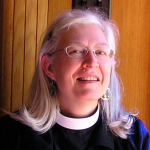A Holy Lent
Lent 1
The greatest hindrance to growing in our understanding of life, faith, Jesus, the World and the World to come is our present understanding of life, faith, Jesus, the World and the World to come. It’s hard to learn what we think we already know. And that may be our greatest problem: We don’t know what we don’t know.
This morning we read about Noah and the flood, and then about Jesus getting baptized, going off into the desert and coming back to proclaim the good news. The Epistle makes the connection between Noah and the flood and baptism. So let’s unpack this a bit.
Every Middle Eastern creation story has some kind of major flood in it. When we think about living in the desert, one that is quite similar to the Mojave, we think of dry land, not floods. And yet, when I was growing up in Los Angeles, which is also desert land, the streets all had great dips, and occasional storm drains, and we were warned as children to never try to get across the water when it filled up the dips, because every year, children drowned. It does rain in the desert, and when it does, it is very dangerous. The water comes suddenly and fiercely and can kill quickly. The idea that this dangerous water might come and stay would be frightening, because obviously everything would die. We also have to retrain our minds to think about what the “world” was at that point. Most people would be born, live, and die in the same village. That was their world. It would have included a few villages around them, but not much more. Even living in a city – the city became the world, and it is as though very soon outside the city walls and the immediate villages outside those walls, the lights went out, and there was nothing else. Because of this, it would be possible for there to be a flood that wiped out an area, without that area having to have been very large from our standards, and for the few survivors to understand their survival as decreed by God.
But the more important thing, for the followers of the way of Jesus, was the early representation of the flood water as an image of death, and that God redeemed the elect, even from the water, through the water, which has now become the water of baptism. In our baptismal rite, we talk about “entering into death.” We symbolically walk down the steps into the baptismal waters – the waters of death. The old baptismal fonts made this very clear. You walked down steps on one side, and up the other, having been resurrected after dying in the baptism itself. Baptism is a dying to the old self. We choose to die, in the hope that God will raise us up from death, just like God raised Jesus. As I told a little girl who was here last week, Jesus is our elder brother, the first-born. He leads the way. He does not just tell us about the way, he shows us by going first, so he becomes the way. That made sense to her.
When we look at the gospel reading, it is classic Mark, boom, boom, boom. These are all topic sentences, only the paragraphs that should follow each one to explain them are not there. First we have the baptism, boom! Next sentence: the Spirit immediately drove him into the wilderness. Boom! Remember in Mark, everything is right now! And it is the Spirit, not the Devil, that drives him into the wilderness. In the wilderness, Satan tempted him, but it was the Spirit that made him go. Third, Jesus starts his ministry with the proclamation to repent and believe in the good news. We have to go to the other Gospels to get some more details, but remember, Mark was the first Gospel to be written down, and therefore, from my perspective, the most reliable and least nuanced. So it’s kind of like, what do we really know? We know that Jesus went to John and was baptized, and that this was controversial, and it also was seen as terribly important. As soon as that happened, Jesus left town. How long? Could be 40 days, which we know is a symbolic number, could be three years, another symbolic number, we don’t know. And where did he go? Could be just out in the Judean wilderness, there’s plenty of that, some people think he went to India and learned a lot from the gurus there. Who knows? What we do know is that when he came back, he was a man with a mission, a man willing to pick up the mantle of John. Remember last week with the story of Elijah and Elisha? When Elijah has been taken up to heaven, Elisha picks up his mantle, strikes the water, and the water parts for him. The mantle is the symbol of power. John has been arrested and will soon be killed. Jesus picks up where he left and goes forward. He had to be fully aware that he did not have long before they came for him. There was good reason he worked mostly in the countryside and stayed out of Jerusalem until the end. Politically, it was the only way he lasted as long as he did.
One of the ways to read Scripture is to read it as though we were in the story. Rather than being an objective reader, what we do with this is to imagine that we are there, and we can play any part of the story. Sometimes it is interesting to read the story several times imagining that we are different characters. So we can imagine that we were there at the Jordan, maybe we are on the bank, having just been baptized, waiting for our clothes to dry back out in the hot sun. Perhaps we are a little surprised that we decided to do this, to come down here to the river, but perhaps it just seemed like the right time to do something different. John had important things to say. And there we were when there seemed to be a small commotion, and we saw John and heard him saying no, no! And then saw this other man be baptized, and realizing that something big had just happened. It was like an earthquake, but nothing fell down, and later, when we started hearing more about Jesus, we would remember this.
Or perhaps we are very daring and play the part of Jesus, not sure what is going to happen next, but sure that the next step was to ask John for baptism, and hearing the voice from heaven saying you are my child, you please me with what you are doing. And before anything else could happen, feeling almost pushed to grab coat and staff, bag and sandals and run out the door before anyone could ask where are you going? The desert, the place of emptiness, the place for a different kind of learning. Sometimes it takes a desert to bring us to a desperation which can lead us to a humility making way for the kind of learning that leads to breakthrough growth. Sometimes people talk about the “dark night of the soul” which is an emotional desert. This is entirely different from depression, although it sometimes looks similar from the outside.
When we let go, and allow ourselves to acknowledge the desert, we can learn what is there. The word “disciple” comes from the Greek word “mathetes” which means, “learner.” A disciple is not one who learns by mastering information, rather a disciple is one who learns by submitting to a master. A disciple is one who sits at the feet of the master. Our master invites us to repent, that is, to turn from the ways we have been going, and to really believe in the good news.
This is, therefore, an invitation to a Holy Lent. Lent invites us to a desert of deepening for the sake of Divine Love. Lent is not about fasting, though fasting is a key path toward deepening. Lent is not about becoming more disciplined, though discipline comes from the root word, disciple. Lent is not about developing an instagram oriented designer spirituality so others can #checkoutmyperfectlife. If ever there were a season for #nofilter and no selfies, it is Lent.
Lent opens a time for getting in touch with the holy discontent that comes from having too much of that which does not ultimately matter and too little of that which actually does. Lent unfolds a path allowing holy discontent to lead us into a brokenness before God. That brokenness may look like a real-messed-up-ness or a not-quite-right-ness or a somewhere-in-between-ness. Lent extends the invitation to let our brokenness before God lead us to a deeper surrender and truer submission to Jesus. And the outcome? Through this qualitatively different kind of surrender, Lent reveals all the human possibilities of participating in the Divine Nature. Lent shows us how we may escape the corruption that is in the world and how to live extravagantly generous lives in the embrace of Holy Love.


